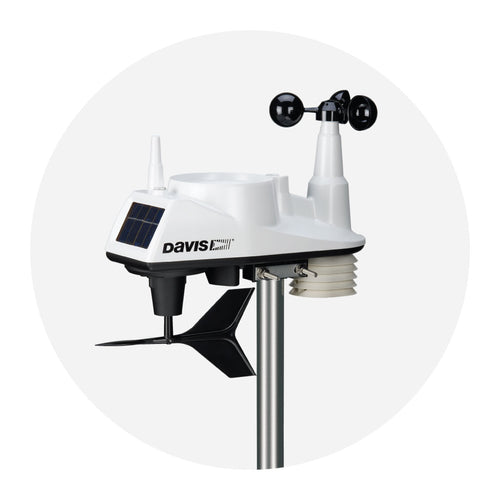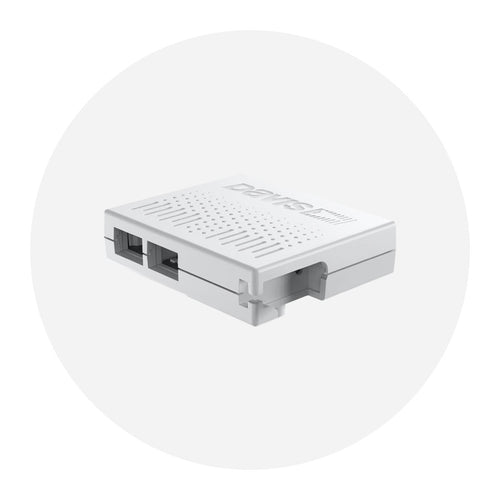
Can AirLink help protect drivers from dangerous dust storms?
 Weather photographer John Sirlin took this gorgeous shot of a haboob pushing across a central Arizona desert. Used with permission.
Weather photographer John Sirlin took this gorgeous shot of a haboob pushing across a central Arizona desert. Used with permission.
What do Weather Buffs think of when they think of Phoenix, Arizona? Haboobs, of course! Dramatic, and dangerous, the haboobs of Phoenix roll thick clouds of dust over homes, roadways, swimming pools, and everything else in their path. A network of Davis AirLink air quality monitors might be the key to real protection from the danger of dust storms.
A haboob, besides being the most fun weather word to say, is a dust or sandstorm that forms due to cold downdrafts from a thunderstorm. The downdrafts, or microbursts, spread out on the ground and pick up loose dust. The resulting storm can be beautiful, as weather photographers like John Sirlin who took the photo above and Mike Oblinski have demonstrated, and also dangerous to anyone caught in one while driving, or even breathing, outside. (You might remember that we featured a gorgeous image by Mike on the cover of our 2020 catalog.)
Lifelong Weather Buff and recently-retired meteorologist Ken Waters knows all about the dangers of dust storms in his home town of Phoenix. Originally from the San Francisco Bay area, Ken moved to Phoenix from Hawaii a few years ago - a move that made him into a haboob expert.
 Ken moved to Phoenix a few years ago. That move made him into a haboob expert.
Ken moved to Phoenix a few years ago. That move made him into a haboob expert.
“I moved from the Hawaii to Phoenix in 2007,” he told us. “My focus had been tropical meteorology. I became a meteorologist while I was in in the US Air Force; I worked in Guam, Japan, Korea, and Okinawa studying typhoons. Phoenix, though, not so tropical.”
But weather is everywhere. What Phoenix lacked in typhoons, it made up for in haboobs. Ken became the Warning Coordination Meteorologist for the NWS in Phoenix. (You can look over a presentation on his 2000-2001 dust-related accident analysis here.)
Arizona dust storms, are most likely to happen in the summer and primarily in the southern half of the state. They can “fetch,” or track, as long as 300 miles and zip along at a typical speed of 40 miles per hour. The wall of dust can tower as high as 8,000 feet.
An Arizona dust storm is unpredictable and unexpected and can take visibility down to 0 in seconds. You might be driving down the highway when suddenly you see a wall of dust rolling toward you. You won’t have time to turn around or head for home. All you can do is pull over safely and wait for it pass. If you are caught outside in one, you need to take cover. The dust isn’t just blinding -- it can damage your lungs as well.
“Dust storms are not just dangerous to drivers. The particulate matter in them is dangerous to breathe, and can even contain the fungus that causes valley fever, a serious lung infection,” Ken said. And with climate change, experts like Ken expect that dust storms will become even more severe and more frequent.
The problem, Ken realized, was the lack of reliable observational data sources. Radar often misses dust storm conditions, surface observations are sparse, and satellite is often useless due to clouds. What Phoenix needed was a network or real-time ground observation sources. Such observational data would give transportation safety officials a longer window to warn drivers and others in the path of the storm.
“My idea was to put lots of particulate matter monitors out to detect sudden changes in PM10 and send alerts to transportation authorities,” Ken said.
He started using low cost particulate matter monitors with Arduino and Raspberry Pi. The monitors took observations every minute and passed them on to the Cloud.
And now, along comes Davis’s AirLink air quality monitor. Ken was quick to order his. He was pleased to find that AirLink not only reports PM2.5 and PM10, which covers the size of many dust and sand particles, it also reports the concentration of smaller particles in PM1 readings – something most other consumer air quality monitors don’t do.
His AirLink data will add to what his 13-year old Vantage Pro2 reports. “I often see a dramatic, simultaneous drop in T and increase in Td [dewpoint depression, or the difference between the temperature and the dew point] as the outflow boundary passes,” he told us.
“Right now,” Ken said, “when I look at the air quality map on WeatherLink.com, I only see one other AirLink in the entire greater Phoenix area and it is located only within 3 or 4 miles of me. I am a big fan of crowd sourcing and automation, and I like what Davis has done. I am looking forward to seeing a whole network of AirLinks in this area. I want all the data I can get my hands on!”
He foresees a time that this data will allow even greater accuracy in forecasting dust storms and the faster alerting of highway safety teams.

We think it’s a great use of our AirLink monitors and it underscores the value of making your system and its current data publicly available on the WeatherLink.com map.
| Learn More about AirLink > | Buy Now > |
In the face of escalating environmental risks, AEM is the essential source for insights on weather, climate, lightning, floods, wildfires, water management, and more.
Learn more about AEM and all of our solutions here.





















